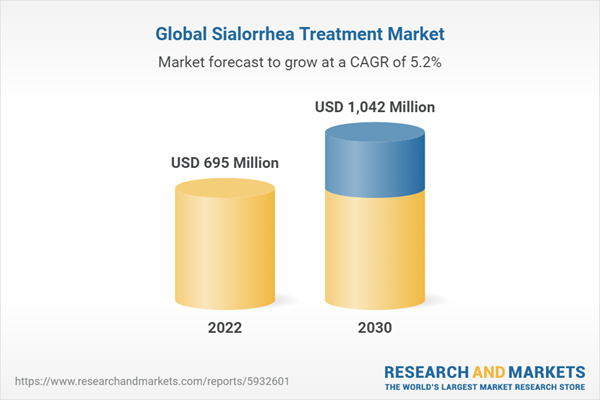The Sialorrhea Treatment Market was valued at US$ 0.695 billion in 2022 and is expected to reach US$ 1.042 billion by 2030; it is estimated to record a CAGR of 5.2% from 2022 to 2030. The market growth is attributed to the increasing prevalence of neurodegenerative disorders and the availability of various treatment options for sialorrhea. Moreover, rising research and development (R&D) and new drug approvals will likely fuel the sialorrhea treatment market growth in the coming years. However, challenges related to sialorrhea treatment restrain the market growth.
Treatments for sialorrhea include behavioral and lifestyle counseling, medication, surgery, and radiation. Nonpharmacological therapies include advice on posture, controlling swallowing, managing cough, dietary adjustments, eating and drinking procedures, and behavioral modification. Nevertheless, these conservative measures might not work for individuals with neurological problems that worsen over time. Many drugs that have been used to treat sialorrhea also have anticholinergic properties that have been utilized to control hypersalivation. Amitriptyline, procyclidine, and rihexyphenidyl are a few of these. Most medications have co-morbidities (such as discomfort or trouble sleeping) and hypersalivation, which makes them potentially helpful in some situations. Therefore, the availability of various treatments for sialorrhea is expected to boost market growth in the coming years.
However, diagnosis and treatment of chronic sialorrhea are delayed due to patient and healthcare professional ignorance about the condition. This is anticipated to be the main obstacle impeding the market expansion for chronic sialorrhea treatments. Furthermore, it is anticipated that healthcare professionals - including specialists and primary care doctors - will know very little about persistent sialorrhea as a separate illness.
A few of the major primary and secondary sources referred to while preparing the report on the sialorrhea treatment market are the World Health Organization (WHO) and the Parkinson's Foundation, among others.
Treatments for sialorrhea include behavioral and lifestyle counseling, medication, surgery, and radiation. Nonpharmacological therapies include advice on posture, controlling swallowing, managing cough, dietary adjustments, eating and drinking procedures, and behavioral modification. Nevertheless, these conservative measures might not work for individuals with neurological problems that worsen over time. Many drugs that have been used to treat sialorrhea also have anticholinergic properties that have been utilized to control hypersalivation. Amitriptyline, procyclidine, and rihexyphenidyl are a few of these. Most medications have co-morbidities (such as discomfort or trouble sleeping) and hypersalivation, which makes them potentially helpful in some situations. Therefore, the availability of various treatments for sialorrhea is expected to boost market growth in the coming years.
However, diagnosis and treatment of chronic sialorrhea are delayed due to patient and healthcare professional ignorance about the condition. This is anticipated to be the main obstacle impeding the market expansion for chronic sialorrhea treatments. Furthermore, it is anticipated that healthcare professionals - including specialists and primary care doctors - will know very little about persistent sialorrhea as a separate illness.
The report segments the sialorrhea treatment market as follows:
The sialorrhea treatment market is bifurcated based on medical therapy and end users. The market is segmented by medical treatment into pharmacologic therapy, radiotherapy, and others. The sialorrhea treatment market, by end-user, is segmented into hospitals, specialty clinics, home care settings, and others. The sialorrhea treatment market, based on geography, is categorized into North America (the US, Canada, and Mexico), Europe (France, Germany, Italy, the UK, Spain, and the Rest of Europe), Asia Pacific (Australia, China, Japan, India, South Korea, and the Rest of Asia Pacific), the Middle East & Africa (Saudi Arabia, the UAE, South Africa, and the Rest of Middle East & Africa), and South & Central America (Brazil, Argentina, and the Rest of South & Central America)Medical Therapy-Based Insights
Based on medical therapy, the sialorrhea treatment market is segmented into pharmacologic therapy, radiotherapy, and others. In 2022, the pharmacologic therapy segment held the largest market share. Also, the segment is expected to record the highest CAGR from 2022 to 2030. Vaccines provide active acquired immunity against particular infectious diseases. In multiple independent clinical trials, pharmacological treatments such as benztropine, glycopyrrolate, scopolamine, and botulinum toxins have been demonstrated to be effective in managing sialorrhea. Medications are delivered orally or parenterally. Botulinum toxin is injected into the salivary gland guided by anatomical external palpation or ultrasonography.End User-Based Insights
The sialorrhea treatment market, by end-user, is segmented into hospitals, specialty clinics, home care settings, and others. The hospitals segment held the largest market share in 2022 and is anticipated to record the highest CAGR during 2022-2030. The treatment for sialorrhea is done in hospitals through appropriate treatment and motor therapy, with the help of highly experienced interdisciplinary medical specialists, including physiotherapists and neurology specialists.A few of the major primary and secondary sources referred to while preparing the report on the sialorrhea treatment market are the World Health Organization (WHO) and the Parkinson's Foundation, among others.
Table of Contents
1. Introduction
2. Executive Summary
4. Sialorrhea Market Landscape
5. Sialorrhea Market - Key Market Dynamics
6. Sialorrhea Market - Global Market Analysis
7. Sialorrhea Market - Revenue Analysis (Usd Million) - by Medical Therapy, 2020-2030
8. Sialorrhea Market - Revenue Analysis (Usd Million) - by End-user, 2020-2030
9. Sialorrhea Market - Revenue Analysis (Usd Million), 2020-2030 - Geographical Analysis
10. Industry Landscape
11. Competitive Landscape
12. Sialorrhea Market - Key Company Profiles
13. Appendix
Companies Mentioned
- Sialorrhea Treatment Market
- Pfizer Inc
- F. Hoffmann-La Roche Ltd
- Mylan N.V.
- Fresenius Kabi AG
- Hikma Pharmaceuticals PLC
- Novartis AG
- Teva Pharmaceutical Industries Ltd.
- Bristol Myers Squibb Company
- GSK Plc.
- Bayer AG
- Sun Pharmaceutical Industries Ltd
Table Information
| Report Attribute | Details |
|---|---|
| No. of Pages | 150 |
| Published | December 2023 |
| Forecast Period | 2022 - 2030 |
| Estimated Market Value ( USD | $ 695 Million |
| Forecasted Market Value ( USD | $ 1042 Million |
| Compound Annual Growth Rate | 5.2% |
| Regions Covered | Global |
| No. of Companies Mentioned | 12 |









